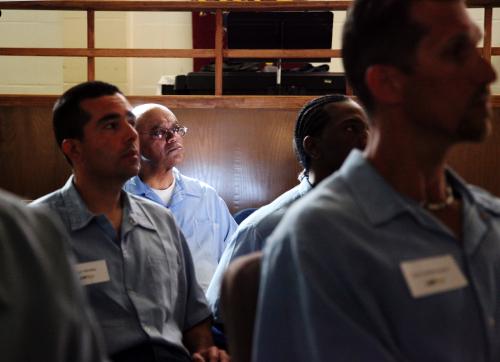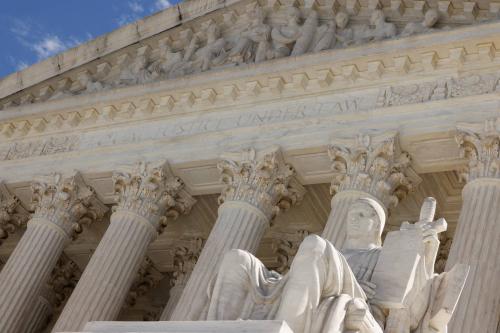For the third year in a row, in 2021, President Biden declared April as Second Chance Month for former prisoners who have reentered their local communities.[1] Prior to his proclamation, efforts have increased to bring more attention to this critical issue, especially as the number of prisoners released from incarcerating institutions across the country continues to grow. Right now, the U.S. Department of Justice (DOJ) estimates that between 650,000 to 750,000 people are released every year. Many of them face major reentry challenges.
Despite its current importance, prisoner reentry is not a new issue as it has been part of American society since 1790. That year, the first known U.S. prison opened in Philadelphia. It was called the Walnut Street Jail, and was built according to principles espoused by Quakers who advocated for a regulated correctional environment, discipline, solitary sleeping cells, and measures to restore defective minds. The purpose of these principles was to change the spirit and habits of the incarcerated, but also set in motion three interrelated issues: incarcerating people was intended to be temporary; serving time in prison was expected to rehabilitate defective minds; and prisoners were to be released, eventually. While the goal of rehabilitation has waxed and waned since 1790, incarceration and reentry have remained constant.
Due to the increasing number of prisoners returning to society, the DOJ held an inaugural National Reentry Week the last week of April in 2016. It sponsored hundreds of events to raise awareness, encouraged partnerships, and educated the public about the importance of having people succeed at reentering society after serving time in prison.
Momentum from 2016 carried into the following year when the Prison Fellowship declared April Second Chance Month, which was devised to harness the national movement and turn National Reentry Week into a monthlong series of events. In 2017, the nationwide effort was supported by the U.S. Senate, which passed a resolution, and several proclamations were passed by state and local communities. In 2018, the White House declared April as Second Chance Month.[2] In 2019, official proclamations and bipartisan support increased to name April Second Chance Month, and in 2020, national and local events were adapted to virtual platforms.
Second Chance Month is designed to bring increased nationwide media attention to “prisoner reentry” — a phrase used to describe the process men and women undergo when released from an incarcerating institution, such as a federal or state prison, and return to society. In theory, adults reentering after serving time in prison should follow a path that leads to making meaningful and productive contributions to their family, community, and society. This theoretical path includes finding legal employment, securing stable housing, and reuniting with family. It also includes participating in educational programs and activities aimed toward personal improvement, like counseling, and leading a crime-free life.
In practice, however, this path is followed by only a small number of returning adults. Instead, most adults’ reentry experiences consist of many hairpin curves and dead-ends. Reentry experiences for the majority of adults are challenging because when exiting prison, individuals have access to differing levels of financial resources, familial support, agency, social capital, coping skills, job and/or vocational experiences, and educational backgrounds. They also have diverse levels of emotional and psychological well-being. Research shows that criminal justice-involved populations contend with the burden of chronic health and medical conditions, as well as increased rates of mental illness, which are exacerbated while incarcerated. When adults return home, those who can rely on familial support, access financial resources, and find stable housing, tend to reenter successfully. They are rarely, if ever, involved in the criminal justice system again. For those who are unable to access resources or do not have families able or willing to support them, individual burdens and deficits follow them home to rural, suburban, and urban communities. Once home, these individuals encounter the collateral consequences of a felony conviction.
In 2019, the U.S. Commission on Civil Rights’ report titled Collateral Consequences: The Crossroads of Punishment, Redemption, and the Effects on Communities,[3] reviewed various collateral consequences at the federal and state levels that are implemented after someone has served time in prison. Collateral consequences refer to a range of policies outside of the criminal justice system that restrict, hinder, or disqualify individuals from accessing public and private benefits. Collateral consequences are connected to one’s past felony conviction(s), and include barriers to public and private housing, public assistance such as SNAP or TANF, voting and jury duty, getting a driver’s license, parental rights, and access to employment opportunities including occupational and professional licenses. These policy restrictions vary across jurisdictions. When implemented, punishment is extended beyond the original criminal sentence while successful reentry is limited to those who were privileged prior to being incarcerated (i.e., Martha Stewart).
The U.S. Commission on Civil Rights argues that collateral consequences increase recidivism rates by barring reentering adults from accessing needed resources, and the range of policies that limit access to legal jobs, housing, and public assistance are not related to protecting the public’s safety. Instead, collateral consequences make reentry harder because they have no time limit and operate as an extended punishment beyond the sentence imposed by the criminal courts. The collateral consequences lead to a large percentage of former prisoners remaining unhoused, unemployed, and disconnected from social institutions, resulting in high recidivism rates. Approximately 67% of released prisoners are arrested again within three years — a percentage that has remained steady for over 30 years.
For more information that explores the connections between public policies and lived experiences of returning citizens, you can read my book, Convicted and Condemned: The Politics and Policies of Prisoner Reentry (NYU Press), which demonstrates how policies extend punishment rather than help returning adults successfully reenter. During this important month, it is crucial to understand problems facing reentering prisoners and establish policies that put them in a better position for success.
Footnotes
- A Proclamation on Second Chance Month, Presidential Actions, https://www.whitehouse.gov/briefing-room/presidential-actions/2021/03/31/a-proclamation-on-second-chance-month-2021/. (Back to top)
- President Donald J. Trump Proclaims April 2018 as Second Chance Month, https://trumpwhitehouse.archives.gov/presidential-actions/president-donald-j-trump-proclaims-april-2018-second-chance-month/. (Back to top)
- U.S. Commission on Civil Rights, 2019 Report, Collateral Consequences: The Crossroads of Punishment, Redemption, and the Effects on Communities, https://www.usccr.gov/files/pubs/2019/06-13-Collateral-Consequences.pdf. (Back to top)







Commentary
April is Second Chance Month
April 14, 2022